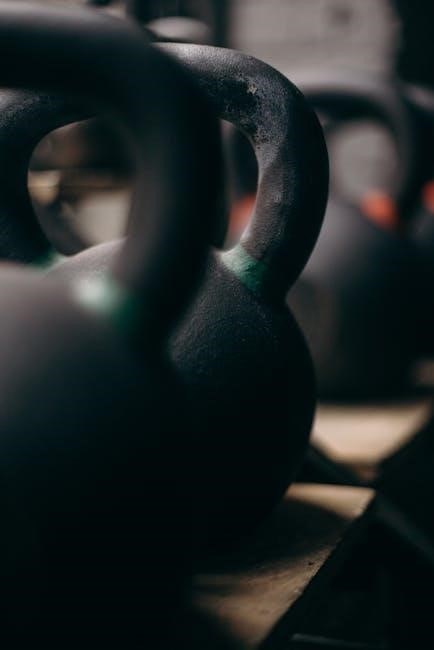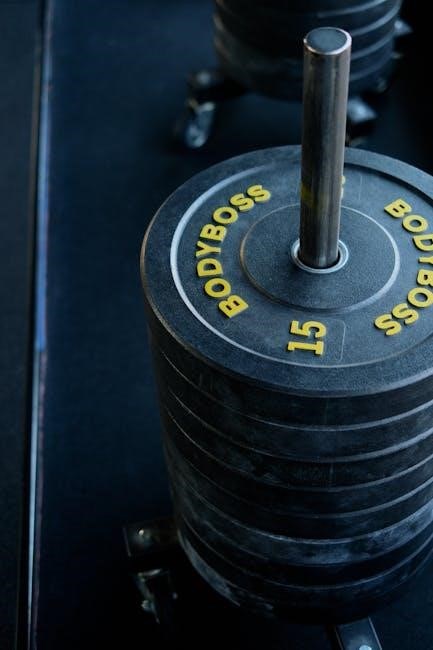Importance of Basketball Strength and Conditioning Programs
A well-structured basketball strength and conditioning program enhances performance, prevents injuries, and builds resilience. It improves power, speed, and endurance, ensuring athletes meet the sport’s demands safely and effectively.
1.1. Role in Injury Prevention and Performance Enhancement
A basketball strength and conditioning program plays a crucial role in injury prevention by strengthening muscles, improving flexibility, and enhancing functional movement patterns. It also boosts performance by increasing power, speed, and endurance, allowing players to excel on the court. A well-designed program ensures athletes can handle the physical demands of the sport while minimizing the risk of injuries.
1.2. Benefits for Young Athletes and Professional Players
Basketball strength and conditioning programs offer significant benefits for both young athletes and professionals. They build foundational strength, enhance athleticism, and improve overall performance. For young athletes, these programs promote long-term development and injury resilience. For professionals, they optimize performance, extend careers, and maintain a competitive edge. Both groups gain increased power, speed, and endurance, essential for success at all levels.
Designing a Basketball Strength and Conditioning Program
A basketball strength and conditioning program should be structured with periodization, focusing on key components like strength, power, and endurance, tailored to seasonal demands and athlete needs.
2.1. Periodization and Seasonal Planning
Periodization in basketball strength programs ensures athletes peak at key moments. Seasonal planning divides training into phases: offseason, preseason, in-season, and postseason. Each phase focuses on specific goals, like building strength in the offseason or maintaining endurance during the season. This structured approach optimizes performance, reduces injury risk, and aligns with competition demands, ensuring sustained progress throughout the year.
2.2. Key Components: Strength, Power, Speed, and Endurance
Strength training builds muscle and enhances durability, focusing on key areas like legs and core. Power development, through plyometrics and medicine ball exercises, improves explosiveness for jumps and sprints. Speed drills, such as ladder exercises, boost agility and quickness. Endurance training ensures sustained performance over the game’s duration. Together, these components create a well-rounded athlete, capable of meeting basketball’s intense physical demands while reducing injury risks.

Injury Prevention Strategies
Injury prevention focuses on building resilience through core stability, functional training, and flexibility exercises. Proper warm-ups, dynamic stretching, and recovery techniques further reduce the risk of injuries.
3.1. Core and Functional Training
Core and functional training are essential for basketball players, enhancing stability, balance, and overall athleticism. Exercises like planks, bird dogs, and medicine ball workouts improve core strength, reducing injury risk. Functional movements mimic game scenarios, boosting agility and power. A strong core ensures better posture, endurance, and explosive movements, directly translating to improved performance on the court.
3.2. Flexibility and Mobility Exercises
Flexibility and mobility exercises are crucial for basketball players, enhancing range of motion and reducing injury risk. Dynamic stretching, yoga, and foam rolling improve joint mobility, allowing for better movement efficiency. These exercises also promote recovery, ensuring players maintain optimal performance throughout the season. Incorporating flexibility routines helps athletes achieve higher leaps, quicker sprints, and sharper cuts on the court.

Nutrition and Recovery for Optimal Performance
Proper nutrition and recovery are vital for basketball performance. They fuel energy, aid muscle repair, and enhance endurance, ensuring peak physical condition throughout the season.
4.1. Nutritional Guidelines for Basketball Athletes
A well-planned diet is essential for basketball athletes, focusing on protein, hydration, and carbohydrates to fuel energy and recovery. Emphasize whole foods, lean proteins, and balanced meals, while avoiding processed sugars and unhealthy fats; Proper nutrition supports muscle repair, endurance, and peak performance, ensuring athletes are prepared for both practice and competition.
4.2. Recovery Techniques: Foam Rolling, Stretching, and Sleep
Recovery is crucial for basketball athletes to rebuild muscle, enhance flexibility, and maintain performance. Foam rolling and stretching improve circulation and reduce muscle soreness, while quality sleep aids in tissue repair and mental recovery. Prioritizing these techniques ensures athletes recover effectively, allowing them to train and compete at their best consistently.

Plyometrics and Explosive Training
Plyometric exercises like box jumps and depth jumps enhance explosiveness and power, crucial for basketball performance. These drills improve jumping ability and overall athletic explosiveness efficiently.
5.1. Box Jumps and Depth Jumps
Box jumps and depth jumps are essential plyometric exercises that enhance explosiveness and power. Box jumps involve jumping onto a box to improve vertical leap, while depth jumps require jumping down and immediately exploding upward to build reactive strength. These drills are crucial for basketball players, as they directly translate to increased jumping ability and more powerful movements on the court, aiding in rebounds, dunks, and fast breaks. Consistency in these exercises ensures improved performance and durability.
5.2. Medicine Ball Exercises for Power Development
Medicine ball exercises are versatile tools for enhancing power and core strength in basketball players. Drills like medicine ball throws, slams, and rotational tosses improve explosive force and rotational power, crucial for driving to the basket and defending. These exercises also boost core stability, translating to better balance and overall court performance, making them a key component of any basketball strength and conditioning program. Regular practice ensures optimal development.

Agility and Conditioning Drills
Agility and conditioning drills enhance speed, quickness, and reaction time, essential for basketball. Ladder drills improve footwork, while pro agility shuttles test directional changes and acceleration, preparing players for game demands.
6.1. Ladder Drills for Foot Speed and Coordination
Ladder drills are essential for improving foot speed, agility, and coordination in basketball. Exercises like high knees, lateral shuffles, and carioca drills enhance quickness and precision. Players weave through ladders, performing rapid foot strikes, which boosts reaction time and balance. These drills are versatile, allowing athletes to mimic game-specific movements, preparing them for fast-paced scenarios on the court. Regular practice ensures better control and explosive acceleration.
6.2. Sprints and Pro Agility Shuttle
Sprints and pro agility shuttles are vital for developing explosive speed and agility. Sprints improve linear acceleration and endurance, while the pro agility shuttle enhances lateral speed and change of direction; These drills mimic basketball’s dynamic movements, helping players quickly navigate the court. Incorporating these exercises into training boosts overall performance and adaptability during fast-paced game situations. Regular practice ensures athletes can maintain high intensity over time.

In-Season Strength Maintenance
In-season strength maintenance focuses on sustaining athletes’ strength and power without overtraining. Short, efficient workouts during this period ensure players remain robust while balancing game demands effectively.
7.1. Balancing Strength Training with Game Demands
Balancing strength training with game demands ensures athletes maintain peak performance without overtraining. In-season workouts are tailored to complement game schedules, focusing on short, intense sessions that preserve strength and power. This approach prevents fatigue and injury, allowing players to sustain their physical capabilities throughout the competitive season effectively.
7.2. Maintaining Power and Endurance
Maintaining power and endurance during the season involves balancing strength workouts with skill practice. Plyometric exercises and high-intensity interval training sustain explosive performance. Conditioning drills like sprints and agility work keep endurance levels high. These strategies ensure players maintain their physical edge, allowing them to perform at peak levels throughout the season without compromising speed or stamina.

Off-Season Training Strategies
Off-season training focuses on building strength, agility, and endurance. Programs include weightlifting, plyometrics, and conditioning drills to improve power and speed, preparing athletes for the next season.
8;1. Building a Foundation of Strength
Off-season strength training is crucial for basketball players. It involves weightlifting, bodyweight exercises, and functional movements to enhance muscle development. Programs focus on multi-joint exercises like squats and deadlifts to build overall power. Emphasizing proper form and progressive overload ensures a solid strength base, reducing injury risk and improving performance. This phase lays the groundwork for more intense training.
8.2. Increasing Speed and Agility
Off-season training emphasizes speed and agility through plyometric exercises, ladder drills, and sprints. These activities enhance explosive power and quick directional changes, crucial for basketball. Players engage in box jumps, depth jumps, and shuttle runs to improve acceleration and reaction time. Agility drills like cone weaves and zigzag runs refine coordination and balance, ensuring athletes are faster and more elusive on the court.

Sample Workout Plans and Schedules
Sample workout plans include 8-week bodyweight strength programs and summer lifting schedules. These structured plans focus on progressive overload, ensuring athletes build strength and endurance systematically.
9.1. 8-Week Bodyweight Strength Program
This program focuses on building foundational strength using bodyweight exercises like push-ups, squats, and planks. It progresses weekly, increasing reps or intensity to enhance muscular endurance and power. Designed for basketball players, it targets key muscle groups to improve performance and durability, ensuring a strong, injury-resistant physique by the end of the 8-week cycle.
9.2. Summer Lifting and Conditioning Schedule
The summer schedule combines strength training and conditioning to maximize off-season gains. It includes 4 lifting days, focusing on lower and upper body, with 2 days of agility and cardio. Plyometrics and core work are integrated to boost explosiveness and stability. The structured plan ensures progressive overload, preparing athletes for the upcoming season with enhanced strength, speed, and endurance by August.

Measuring Progress and Adjusting the Program
Regular testing and evaluation ensure program effectiveness. Data analysis and athlete feedback guide adjustments, optimizing strength, performance, and recovery strategies for continuous improvement and goal achievement.
10.1. Testing and Evaluation Methods
Regular testing assesses strength, power, speed, and endurance, ensuring progress tracking. Vertical jumps, sprint times, and endurance drills provide measurable data. Athlete feedback and performance metrics guide program adjustments, optimizing results and minimizing plateaus. These evaluations ensure tailored improvements, keeping athletes on track to achieve their goals effectively.
10.2. Adapting the Program for Individual Needs
Programs are tailored to address each athlete’s unique needs, ensuring optimal progress. Personalized assessments identify strengths, weaknesses, and goals, guiding customized workouts. Periodization and flexibility in exercises allow for adjustments based on individual responses and developmental stages. This adaptive approach ensures athletes receive targeted training, maximizing efficiency and minimizing the risk of overtraining or underperformance.

